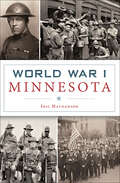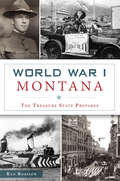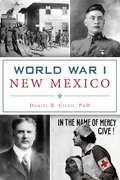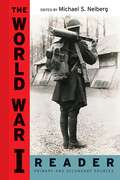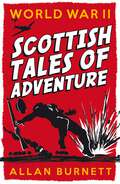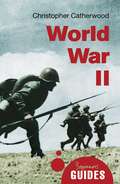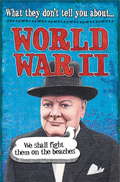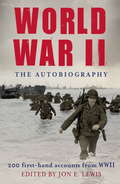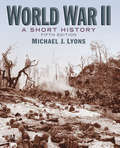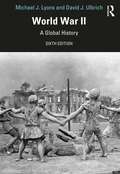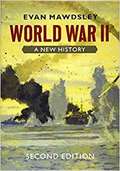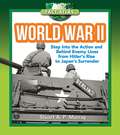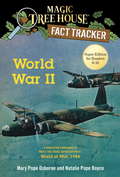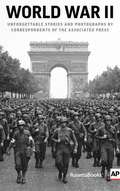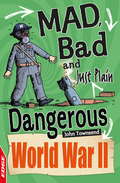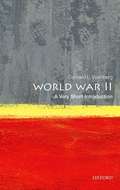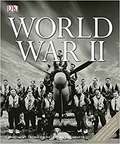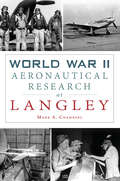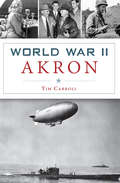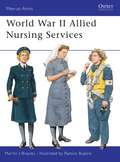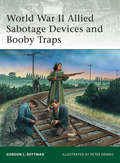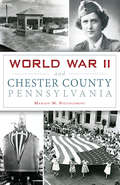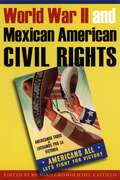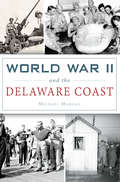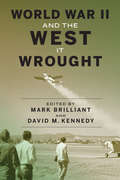- Table View
- List View
World War I Minnesota (Military Ser.)
by Iric NathansonWhen the United States made a formal declaration of war on April 6, 1917, Minnesotans answered the call to arms. Duluth, with its strategic location at the head of the Great Lakes, emerged as a major shipbuilding center. Over forty thousand men registered for the draft in Minneapolis alone. Yet many members of the state's large German American population struggled with divided loyalties. A xenophobic fervor swept through the state at an alarming rate, forcing the government to establish a Commission on Public Safety to stifle wartime dissent. With more than fifty period photos and illustrations, author Iric Nathanson brings to life the daily struggles and triumphs of Minnesotans in the Great War.
World War I Montana: The Treasure State Prepares (Military)
by Ken RobisonMontana's cowboys, miners, foresters, farmers and nurses entered World War I in April 1917 under the battle cry that would resonate on the battlefields in France--"Powder River, Let 'Er Buck!" Montana men served in a greater percentage per capita than any other state. Hundreds responded to the call, including local women and minorities, from the nation's first congresswoman, Jeannette Rankin, to young women serving as combat nurses on the front lines. Additionally, the state provided vital supplies of copper and wheat. Learn what role celebrities like "cowboy artist" Charlie Russell played in the war and how Montanans mobilized, trained and deployed. Acclaimed historian Ken Robison uncovers new and neglected stories of the Treasure State's contributions to the Great War.
World War I New Mexico (Military)
by Daniel R.In 1917, five years after New Mexico received its statehood, the United States entered World War I. With border tensions festering between Mexico and the United States, Germany attempted unsuccessfully to secure Mexico’s allegiance with its Zimmermann Telegram. More than sixteen thousand New Mexicans joined the military, while civilians supported from the home front. Groups like the Knights of Columbus, YMCA and the Salvation Army, as well as Governor W.E. Lindsey’s New Mexico Council of Defense, raised military funding. Author Daniel R. Cillis recounts the Land of Enchantment’s influence on World War I from its beginning through to the 1918 Armistice.
The World War I Reader
by Michael S. NeibergAlmost 100 years after the Treaty of Versailles was signed, World War I continues to be badly understood and greatly oversimplified. Its enormous impact on the world in terms of international diplomacy and politics, and the ways in which future military engagements would evolve, be fought, and ultimately get resolved have been ignored. With this reader of primary and secondary documents, edited and compiled by Michael S. Neiberg, students, scholars, and war buffs can gain an extensive yet accessible understanding of this conflict. Neiberg introduces the basic problems in the history of World War I, shares the words and experiences of the participants themselves, and, finally, presents some of the most innovative and dynamic current scholarship on the war. Neiberg, a leading historian of World War I, has selected a wide array of primary documents, ranging from government papers to personal diaries, demonstrating the war's devastating effect on all who experienced it, whether President Woodrow Wilson, an English doughboy in the trenches, or a housewife in Germany. In addition to this material, each chapter in The World War I Reader contains a selection of articles and book chapters written by major scholars of World War I, giving readers perspectives on the war that are both historical and contemporary. Chapters are arranged chronologically and by theme, and address causes, the experiences of soldiers and their leaders, battlefield strategies and conditions, home front issues, diplomacy, and peacemaking. A time-line, maps, suggestions for further reading, and a substantive introduction by Neiberg that lays out the historiography of World War I round out the book.
World War II: Scottish Tales Of Adventure
by Allan BurnettThe Second World War from a Scottish point of view—stories about men and women, allies and enemies to captivate and intrigue young readers. Acclaimed children&’s author Allan Burnett turns his attention to the Second World War in a book of explosively exciting and emotionally charged tales of bravery and adventure. Featuring the true exploits of soldiers, spies, pilots, sailors and many others, these stories, all based on interviews with these heroes themselves or their descendants, offer a unique, personal insight into the Second World War that no conventional history book can ever hope to match. &“With accounts of life on a variety of fronts this is a valuable introduction to life during the Second World War for younger readers . . . In a slim volume he manages to pack a lot in, allowing the reader a taste of a wide range of views and experiences, and never succumbing to a simplistic goodies versus baddies take on things . . . the heart of the stories themselves is surely universal, reminding us that war is a multi-faceted business affecting different people in all sorts of different ways.&” —Daily Record
World War II: A Beginner's Guide (Beginner's Guides)
by Christopher CatherwoodWith over sixty million casualties, World War II was the bloodiest conflict in history. In this incisive introduction, esteemed academic Christopher Catherwood covers all the key battles and campaigns, while also giving the larger story behind them, putting familiar events into the perspective of the war at large. He explores the huge impact of the preceding Sino-Japanese War on World War II itself; the relative unimportance of the British conflict in Africa; the near moral-equivalence of the Red Army and the Nazis; and the impact of the Hiroshima bombing. Full of text-boxes revealing key details about British intelligence, weaponry, and the social milieu to the conflict, there is no better brief introduction to this landmark event.
World War II (What They Don't Tell You About #31)
by Robert FowkeDid you know that Adolf Hilter wasn't, in fact, German?The Second World War brought horror and heartache to millions of people all over the globe, and it turned everyday living upside down too. Any history book will give you the boring facts THEY think you should know, but only this one will tell you what life during World War II was REALLY like ...
World War II: The Autobiography
by Jon E. LewisHow will the Second World War be remembered? Not as a series of strategic battles but as a dramatic turning point in world history, recorded through the personal accounts, diaries, and speeches of those that were there. World War Two: the Autobiography places centre stage the individual accounts of over 200 people who saw events unfolding before their eyes: from the first stirrings of Nazi aggression, to the phoney war and the Blitzkrieg; from the frozen wastes of the Eastern Front to life under the threat of the Blitz in London. This autobiography offers a panoramic view of the conflict and with entries from all the major figures of the war, including Churchill, Field Marshal Montgomery, Hitler, Stalin and Rommel, as well as accounts from the men and women on the front line, the home front and those unfortunate to be prisoners of war, from all sides of the conflict.
World War II: A Short History
by Michael J. LyonsHighly regarded for its concise clarification of the complexities of World War II, this book illuminates the origins, course, and long-range effects of the war. It provides a balanced account that analyzes both the European and Pacific theaters of operations and the connections between them. The Fifth Edition incorporates new material based on the latest scholarship, offering updated conclusions on key topics and expanded coverage throughout.
World War II: A Global History
by Michael J. Lyons David J. UlbrichFully revised and restructured, the sixth edition of World War II: A Global History offers students a concise and yet thorough textbook that examines history’s bloodiest conflict. The chapters alternate between chronological chapters on Europe and Asia-Pacific and thematic chapters on innovations, home fronts, brutal regimes, and logistics. This textbook includes the following features: A lively narrative of facts, events, people, and ideas that incorporates thoughtful analysis New material and restructured content on global factors that affected the causes, conduct, and consequences of World War II Balanced pace that does not bog readers down in too many details yet gives them sufficient depth and breadth for context Chapters, sections, and sidebars arranged in ways that can complement lectures and assignments Fifty new photographs that illustrate the human condition and weaponry during World War II. Global in focus, by blending both geographic and thematic chapters to ensure readers gain a comprehensive understanding of impact of the war worldwide, this is the perfect volume for all students of the biggest global conflict of the twentieth century.
World War II: A New History
by Evan MawdsleyThis is a revised and updated edition of Evan Mawdsley's acclaimed global history of World War II. Beginning with the outbreak of the Sino-Japanese War, Evan Mawdsley shows how the war's origins lay in a conflict between the old international order and the new and traces its globalisation as it swept through Asia, Europe and the Middle East. <P><P>The primary focus is on the war's military and strategic history, though also examines the political, economic, ideological and cultural factors which influenced the course of events. The war's consequences are examined too, not only in terms of the defeat of the Axis but also of the break-up of colonial empires and the beginning of the Cold War. Accessibly written and well-illustrated with maps and photographs, the book also includes insightful short studies of the figures, events and battles that shaped the war, as well as fully updated guides to further reading.
World War II: Step into the Action and behind Enemy Lines from Hitler's Rise to Japan's Surrender (Fact Atlas Series #No. 6)
by Stuart MurrayThe Fact Atlas series offers an age-appropriate overview of the historic and world-changing events of World War II, covering everything from the rise of Hitler and Nazism to the tragedy of the Holocaust and its long-lasting effects. Readers will be introduced to key players--political and military leaders like Winston Churchill and Franklin Roosevelt as well as Joseph Stalin, Benito Mussolini, and many more. Explore the ideas of democracy versus totalitarianism and international relations as a whole during the 1930s. Learn more about the different countries that became involved in the Second World War, with a focus on most of Europe, the United States, and Japan. Lesser-known facts about the involvement of countries such as China, Libya, Ethiopia, and New Zealand make it very clear that the war touched all corners of our world. Accompanied by photos and maps to outline specific events, this book offers a careful breakdown of how the war played out globally. Battles and campaigns are explained and examined, and young readers will be able to follow the war from beginning to end, analyzing causes and effects of each important event. World War II gives young readers the opportunity to grasp the weight and magnitude of one of the very worst wars the world has seen.
World War II: A Nonfiction Companion to Magic Tree House Super Edition #1: World at War, 1944 (Magic Tree House (R) Fact Tracker #36)
by Mary Pope Osborne Natalie Pope Boyce Carlo MolinariIn the next Magic Tree House® Fact Tracker, track the facts about World War II—with Jack and Annie! When Jack and Annie came back from their adventure in Magic Tree House Super Edition #1: World at War, 1944, they had lots of questions. How did World War II begin? Why were so many innocent people killed? What was D-Day? Find out the answers to these questions and more as Jack and Annie learn all about one of the darkest hours of history. Filled with up-to-date information, photographs, illustrations, and tidbits from Jack and Annie, the Magic Tree House Fact Trackers are the perfect way for kids to find out more about the topics they discover in their favorite Magic Tree House adventures. And teachers can use the Fact Trackers alongside their Magic Tree House fiction companions to meet Common Core text pairing needs. Have more fun with Jack and Annie on the Magic Tree House website at MagicTreeHouse.com! Did you know there’s a Magic Tree House book for every reader? Find the perfect book for you: Classic: Adventures with Jack and Annie, perfect for readers who are just starting to read chapter books. F&P Level M. Merlin Missions: More challenging adventures for the experienced Magic Tree House® reader. F&P Level N. Super Edition: A longer and more dangerous adventure with Jack and Annie. F&P Level P. Fact Trackers: Non-fiction companions to your favorite Magic Tree House® adventures
World War II: Unforgettable Stories and Photos by Correspondents of The Associated Press
by The Associated PressPowerful, visceral, and essential to preserving and understanding our past, the work of Associated Press photographers and journalists lives on through the pages of World War II.Never before in history had the day-to-day struggles and victories of war—from the home front to the front lines—been chronicled in such graphic and unflagging detail as during the Second World War. Nearly 200 photographers and reporters of Associated Press volunteered to cover the war across the globe from 1939 through 1945. The heroic achievements of these reporters and photographers—some of whom gave their lives—are remembered through the stunning photographs and moving firsthand reports of World War II: Unforgettable Stories and Photographs by Correspondents of The Associated Press.World War II commemorates the experiences of the individuals who brought the war into the homes of millions of Americans. Originally published in 1945 as Reporting to Remember: Unforgettable Stories and Pictures of the War by Associated Press Correspondents, this updated anniversary edition includes a new interview with former AP World War II correspondent George Bria, as well as a new Foreword by current AP Vice President for International News John Daniszewski.
World War II (EDGE: Mad, Bad and Just Plain Dangerous #4)
by John TownsendTime to take a sideways look at the bizarre and outrageous from throughout history - and it's all TRUE!Which mad weapons were actually used during combat? Who was the bad guy in charge of the Nazi German air force? Which dangerous mission helped to capture the Nazis' new tank?Find out the answers to these questions inside, along with lots of facts, quizzes, and other bonkers stuff as you take a bumpy journey into the darkest crannies of World War II history with Mad, Bad and Just Plain Dangerous!
World War II: A Very Short Introduction (Very Short Introductions Series)
by Gerhard L. WeinbergThe enormous loss of life and physical destruction caused by the First World War led people to hope that there would never be another such catastrophe. How then did it come to be that there was a Second World War causing twiceas much loss of life and more destruction than any other previous conflict? In this Very Short Introduction, Gerhard L. Weinberg provides an introduction to the origins, course, and impact of the war on those who fought and the ordinary citizens who lived through it. Starting by looking at the inter-war years and the German invasion of Poland in September 1939, he examines how the war progressed by examining a number of key events, including the war in the West in 1940, Barbarossa, the German Invasion of the Soviet Union, the expansion of Japan's war with China, developments on the home front, and the Allied victory from 1944-45. Exploring the costs and effects of the war, Weinberg concludes by considering the long-lasting mark World War II has left on society today.
World War II
by H. P. WillmottA dramatic new illustrated account of the most destructive war the world has ever seen
World War II Aeronautical Research at Langley (Military)
by Mark A. ChambersThe effort to win the war began at home--and for the researchers at Langley Memorial Aeronautical Laboratory, enhancing America's military aviation arsenal was the key to victory.Formed in 1915, the National Advisory Committee for Aeronautics established itself over the next 25 years as one of the world's finest research organizations. When World War II began in 1939, the NACA employed a mere 500 workers and maintained a budget slightly in excess of $4 million. To meet the demands of the war, a special partnership was quickly forged between NACA researchers, industry designers, and military planners. The Langley laboratory possessed world class aeronautical research facilities and flight research operations, making it ideally suited to help America win the war.Military historian Mark Chambers tells the story of the monumental task of developing the planes that spurred Allied victory in World War II.
World War II Akron (Military)
by Tim CarrollWhen World War II engulfed the nation, the men and women of Akron dutifully played their part in the epic struggle. Keyes Beech ducked grenades as marines raised the American flag at on Iwo Jima. Newspaper magnate John S. Knight watched the Japanese surrender on the USS Missouri just five months after his son was killed in Germany. On the homefront, Goodyear manufactured blimps used to hunt down Nazi submarines, and noted Beacon Journal cartoonist Web Brown pledged his talent and his pen to boosting morale at home and abroad. Replete with more than one hundred images, including many of Brown's wartime drawings, this thrilling account by local author Tim Carroll recalls all that Akron gave for freedom.
World War II Allied Nursing Services
by Martin Brayley Ramiro BujeiroThe skill and care of the women of the Allied military nursing services was remembered gratefully by hundreds of thousands of wounded servicemen of World War II (1939-1945). The small peacetime services increased rapidly by enrolling reservists and volunteers; the great majority of the nurses who cared for Allied casualties were 'civilians in uniform', who worked tirelessly under difficult conditions and - in tented hospitals close to the front lines - in real danger; many nurses paid for their devotion with their lives. This first-ever fully illustrated study of the US, British, Commonwealth, and other nursing organisations includes many unpublished photographs and 24 meticulously illustrated colour figures.
World War II Allied Sabotage Devices and Booby Traps
by Gordon Rottman Peter DennisOsprey's elite title dealing with various sabotage devices and booby traps that were used by the British and the Americans during World War II (1939-1945). Following Churchill's directive to set occupied Europe ablaze, the SOE and later its American sister organization, the OSS, were deployed across the continent. Outnumbered, surrounded and in great peril, these brave agents were armed with a wide variety of devices to help them achieve their objectives, including numerous pieces of sabotage equipment and cunning booby traps. This book examines these different pieces of equipment and the technicalities involved in deploying them effectively. It also discusses the specialist equipment developed by Special Forces units, including the SAS Lewes Bomb. Touching on some of the stranger developments, such as explosives disguised as lumps of coal, the author goes on to describe the German clearance techniques that were developed to avoid these dangers.Complete with specially commissioned artwork and period diagrams, together with detailed descriptions of the dangerous missions of Allied agents, this book is a fascinating insight into the secret war behind enemy lines.
World War II and Chester County, Pennsylvania (Military)
by Marion M. PiccolominiRegiments from Chester County fought bravely in all theaters of World War II, while locals at home took extraordinary measures to support the Allies. West Chester resident G. Raymond Rettew developed a process to mass produce vitally needed penicillin while a peaceful farm transformed into the bustling Valley Forge General Hospital in 1943. Women entered labor positions at companies, including Lukens Steel, to meet production demands. The Coatesville YMCA created and distributed a newsletter to soldiers so the boys on the front had the news from back home. Author Marion Piccolomini celebrates the resilience and perseverance of Chester County residents in the midst of total war.
World War II and Mexican American Civil Rights
by Richard Griswold Del CastilloWorld War II marked a turning point for Mexican Americans that fundamentally changed their expectations about how they should be treated by the greater U. S. society. The experiences of fighting alongside white Americans in the military, as well as of working in factory jobs for wages equal to those of Anglo workers, made Mexican Americans less willing to tolerate the second-class citizenship that had been their lot before the war. Having proven their loyalty and "Americanness" during World War II, Mexican Americans in the postwar years wanted to have the civil rights they knew they had earned. In this book, Richard Griswold del Castillo and Richard Steele investigate how the World War II experiences of Mexican Americans galvanized their struggle for civil rights and how the U. S. government responded to the needs and aspirations of Mexican Americans. The authors demonstrate, for example, that the U. S. government "discovered" Mexican Americans during World War II and set about addressing some of their problems as a way of forestalling a sense of grievance and disaffection that might have made the Mexican American community unwilling to support the war effort. The authors also show that, as much or more than governmental programs, the personal wartime experiences of Mexican Americans formed their civil rights consciousness. The book concludes with a selection of key essays and historical documents from the World War II period that collectively gives a first-person understanding of the civil rights struggles of Mexican Americans.
World War II and the Delaware Coast (Military)
by Michael MorganWithin weeks of Pearl Harbor, German U-boats arrived off the Delaware coast and attacked numerous ships along the vital shipping lanes to Philadelphia and Wilmington. On February 28, 1942, two German torpedoes hit the destroyer Jacob Jones, which was carrying more than one hundred American sailors. It sank in less than an hour. A center for military activity, Lewes became a refuge for many survivors from such attacks. The dunes along Cape Henlopen hid the massive artillery batteries of Fort Miles. Residents of the beachfront communities rallied amid the blackout regulations and air raid drills with rationing and scrap drives. Spotters watched for enemy warships in concrete towers that still line the coast. Author Michael Morgan tells the remarkable story of a coast at war.
World War II and the West It Wrought
by Mark Brilliant David M. KennedyFew episodes in American history were more transformative than World War II, and in no region did it bring greater change than in the West. Having lifted the United States out of the Great Depression, World War II set in motion a massive westward population movement, ignited a quarter-century boom that redefined the West as the nation's most economically dynamic region, and triggered unprecedented public investment in manufacturing, education, scientific research, and infrastructure—an economic revolution that would lay the groundwork for prodigiously innovative high-tech centers in Silicon Valley, the Puget Sound area, and elsewhere. Amidst robust economic growth and widely shared prosperity in the post-war decades, Westerners made significant strides toward greater racial and gender equality, even as they struggled to manage the environmental consequences of their region's surging vitality. At the same time, wartime policies that facilitated the federal withdrawal of Western public lands and the occupation of Pacific islands for military use continued an ongoing project of U.S. expansionism at home and abroad. This volume explores the lasting consequences of a pivotal chapter in U.S. history, and offers new categories for understanding the post-war West. Contributors to this volume include Mark Brilliant, Geraldo L. Cadava, Matthew Dallek, Mary L. Dudziak, Jared Farmer, David M. Kennedy, Daniel J. Kevles, Rebecca Jo Plant, Gavin Wright, and Richard White.
